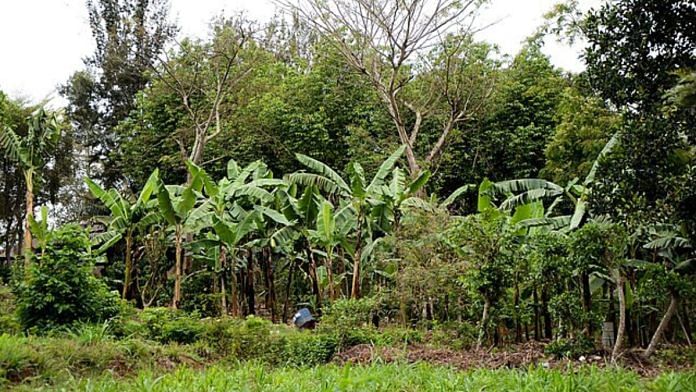Forests are more than just ecological reserves. They are essential sources of uncultivated food, nutrition, and livelihood for millions. From providing wild fruits, nuts, and medicinal plants to supporting soil health and the water cycle, forests sustain agriculture. Yet, their intrinsic connection to food systems often goes unrecognised.
On International Day of Forests—observed on 21 March, with ‘Forests and Foods’ as this year’s theme—the Food and Agriculture Organization of the United Nations (FAO) emphasises the vital role of forests in food security across the globe.
Scaling up agroforestry, which combines agriculture with forestry practices, can make agriculture resilient and boost food production while also preserving ecosystems.
A symbiotic relationship
Forests provide essential ecosystem services that make agriculture sustainable and climate-resilient. They are not only home to pollinators that support crop production but also harbour wild relatives of crop plants, which are essential for crop development. Forests also serve as vast open reserves of wild edible and medicinal plants.
FAO’s Green-Ag project in India, funded by the Global Environment Facility, seeks to form productive landscapes that enhance biodiversity and provide year-round food security. The project integrates forests and agriculture through agroecology across five diverse landscapes: Mizoram, Uttarakhand, Madhya Pradesh, Odisha, and Rajasthan. Implemented in close collaboration with the Indian Ministry of Agriculture and Farmers’ Welfare and the respective state governments, the initiative aims to improve soil fertility, boost water retention, address land degradation, and promote biodiversity conservation including agrobiodiversity.
In Mizoram’s Dampa-Thorangtlang landscape, the Green-Ag project is promoting agroforestry by promoting the plantation of indigenous tree species in traditional jhum lands alongside crops. The project has also prepared a management plan for the Village Supply Reserve—community-managed forest patches traditionally used by each village to supply small timber, fodder, and fuel. The selection of species for plantation has been done in consultation with the community.
The new management plan also has a provision for the plantation of fruit trees along with other species for these supply reserves to support the dietary needs of the local community. This will also enhance the sustainability of the reserve.
In Uttarakhand’s Corbett-Rajaji landscape, traditional mixed farming thrives under forest cover, ensuring food security for mountain communities.
In Madhya Pradesh’s Chambal landscape, Green-Ag is piloting the agri-horti-silvi system, which integrates crops with fruit, vegetable, or ornamental trees on the same land. This approach is being implemented in ravine-affected villages to restore degraded land, boost food production, and diversify income sources for local farmers in the area.
Meanwhile, in Odisha’s Similipal landscape, the project has initiated Miyawaki plantations to restore degraded land and improve biodiversity, alongside promoting mango and cashew plantations in forest fire-prone villages covering 100 hectares. These efforts are enhancing food security and providing alternative livelihoods for local communities.
The Government of India recognises agroforestry as a key strategy for increasing farmers’ income and promoting a carbon-neutral economy. However, the lack of Quality Planting Material (QPM) and a clear certification system has hindered its expansion. The National Agroforestry Policy (2014) emphasises the need to develop and certify QPM. To address this, FAO is assisting the agriculture ministry to develop ‘Protocols for QPM and Certification of Nurseries for Timber and Non-timber Agroforestry Species’.
Also read: How heat affects informal women workers—loss of income, skin infections, domestic violence
Traditional knowledge systems
Forests are a vital source of uncultivated foods. Forest areas, uncultivated commons, and village lands provide an important foraging place for such food. Many wild food plants are highly nutritious and also have healing properties.
Some state governments in India are taking action to highlight the importance of these forgotten foods. In November 2024, the Government of Odisha launched a scheme on the ‘Revival and Sustainable Intensification of Forgotten Foods/Neglected Crops of Odisha’.
FAO advocates the protection of traditional food and seed systems. Preserving indigenous seeds and promoting traditional knowledge ensures that local farmers can cultivate resilient crops suited to their environments, which bolsters food security for generations to come.
Also read: Haryana has no patience for woke narrative on drug abuse and trade. It’s a war
Forests as food providers
To unlock the potential of forests in achieving food and nutrition security, we need urgent and coordinated action. Integrating forests into agrifood systems is the key. Agroecological approaches must be scaled up to create a balance between conservation and productivity.
By encouraging farmers to adopt agroforestry practices, we can cultivate more resilient agricultural landscapes that sustain both people and the planet.
Equally important is the need to strengthen the rights of forest-dependent communities who are the primary custodians of forest ecosystems. Their traditional knowledge is vital for sustainable forest management. Hence, building their capacities to manage these resources sustainably is essential.
Forests are fundamental to the world’s water systems and their health directly impacts the availability of clean water. Sustainable forest management, particularly in critical watersheds, can safeguard water supplies for millions of people.
Forests are also critical allies in the fight against climate change. Acting as carbon sinks, they absorb massive amounts of CO2 from the atmosphere. By protecting and restoring forest ecosystems, we can significantly reduce greenhouse gas emissions while also enhancing biodiversity.
By supporting policies that enable communities to sustainably harvest forest products and market them effectively, we can protect forest ecosystems while fostering sustainable livelihoods for rural households. In this way, forest-based economies can contribute to both poverty alleviation and food security.
As FAO marks its 80th anniversary in 2025, the organisation’s continued commitment to agroecology and sustainable food systems reflects the importance of forests as critical providers of food, water, and livelihoods. A future where forests and food thrive together is not just possible, it is essential if we want to leave no one behind.
Takayuki Hagiwara is the UN Food and Agriculture Organization (FAO) representative in India. Views are personal.
(Edited by Prasanna Bachchhav)




